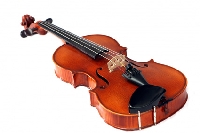
Here’s how to buy viola strings so that your instrument sounds it’s very best
The viola is part of the violin family, but it’s tuned a fifth lower. Lower tuning requires a larger sized instrument than the violin and heavier strings to produce the deeper sound. The thicker strings have a significant impact on the sound you instrument produces.
Whether you’re looking for replacements or wondering how to buy viola strings the first time, it’s important to be aware of the different types of material and tensions. Consider what you’re already comfortable with and whether you wish to experiment with something new. Many players like to try a few different brands until the find one they love.
Ultimately, all the matters is finding the type of string that produces the sound you like. The first consideration is the material they’re made from. This includes: synthetic-core (wound with metal), gut-core (also wound with metal) and all-metal.
There once was a time when bows were made entirely with either sheep or lamb intestines, but these are rare and impractical. They’re expensive, don’t last and go out of tune quickly. That leaves synthetic, metal and gut-core strings to choose from.
~
Here are the major differences:
- Synthetic ? The structure of these strings is simple. The core is made from perlon, kevlar or another synthetic material that’s then wrapped with metal. The sound they produce mimics that produced from gut-core ones, which is rich, warm and noticeably bright.
- Metal ? These strings are basically metal on metal. The core is usually steel wrapped with silver, titanium or more steel. Typically, metal ones stay in tune the longest because humidity and extreme temperatures don’t effect steel as much. Instructors often encourage students to start with metal as they require less maintenance.
- Gut ? Seasoned and professional violists often use gut-core strings for the warmth of their sound. You’ll have to tune and replace them much more often.
Tackle tension
Aside from material, the other important thing to know about how to buy viola strings is the different tensions: light, medium and heavy. Medium is the standard default for many. Beginners may benefit from the lighter tension strings because they’re easier on the fingers. The drawback is less volume.
If you have trouble hearing yourself play, high tension increases the volume and projection, but it’s harder on the fingers.
Getting the right length
It’s easy to forget about fit once you start comparing string materials and feeling various tensions. However, getting the correct length is critical. The size of your viola is measured down the length of the back, but it doesn’t include the neck, end button or the scroll.
To make things more fun, full-sized violas don’t always come in standard sizes as violins, cellos and other types of musical instruments. In fact, the size can range from 11? to 17?! When in doubt as to what a merchant considers ?medium? or ?long? scale, call them to find out the exact length. Strings are typically sold in sets of four so you want to make sure you order the correct length.
Mind the details
Knowing how to buy viola strings means minding the details. They either come with a ball-end or loop-end. The difference is in how the strings will be tuned. Though there are adapters so you can use single-pronged tuners on ball-end strings, you may as well see how your strings are currently tuned and get the same kind.
At first glance, the variety of strings available can be a little overwhelming. Responsiveness, playability and sound quality are huge considerations for students and professional players alike. Take your time deciding because these different characteristics change the sound and your enjoyment playing the viola.
It’s recommended that you change your strings about every six months. After that, the sound quality will gradually degrade. Once you re-string, mark the calendar for when you’re due for new ones!

